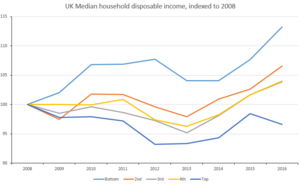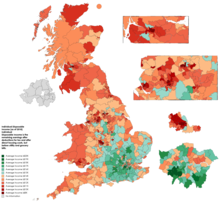This article needs to be updated. (February 2018) |



Median household disposable income in the UK was £29,400 in the financial year ending (FYE) 2019, up 1.4% (£400) compared with growth over recent years; median income grew by an average of 0.7% per year between FYE 2017 and FYE 2019, compared with 2.8% between FYE 2013 and FYE 2017.[2]
The rise in median income has occurred during a period where the employment rate grew by 0.5 percentage points, while real total pay for employees increased by an average of 1.0% across the 12 months in FYE 2019 compared with FYE 2018.[2]
Median income of people living in retired households increased by 1.1% (£300), while the median income of people living in non-retired households grew by 1.3% (£400).[2]
In November 2023, The Trussell Trust calculated that a single adult in the UK in 2023 needs at least £29,500 a year to have an acceptable standard of living, up from £25,000 in 2022. Two partners with two children would need £50,000, compared to £44,500 in 2022. 29% of the UK population – which works out to 19.2 million people – belong to households that bring in below a minimum figure.[3]
- ^ "Household disposable income and inequality in the UK". www.ons.gov.uk.
- ^ a b c "Average household income, UK - Office for National Statistics". www.ons.gov.uk. Retrieved 20 March 2020.
- ^ Este, Jonathan (10 November 2023). "How much income is needed to live well in the UK in 2023? At least £29,500 – much more than many households bring in". The Conversation. Retrieved 12 November 2023.